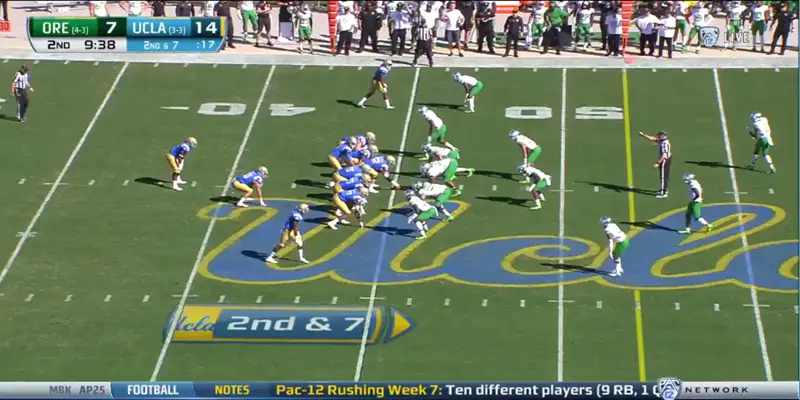Welcome to the sixth installment of X’s vs. O’s. In this series, we will analyze ways in which Oregon utilizes different schemes and techniques to both attack and defend the opposition.
Today, we are looking at a play-action pass scheme against a zone blitz. We’ll briefly review the passing concept, the QB’s play fake, and the pass protection scheme before we review the game film.

Above, we have a basic triangle read for the Quarterback (QB). Against a single-high safety structure, like we see in this example, the QB is taught to read the horizontal stretch created by the S1 hitch route and the S3 flat route. The route by S2 is an alert route in this situation.
An alert route, sometimes called a peek route, gives the QB another option to read before his main read on the play. As the name peek implies, the QB can’t stare down this receiver, he must quickly decide if this is where he is going with the ball early in his dropback.
Depending on the offensive system, the play caller could alert the QB to use the built in alert as his first read based on down-and-distance, situation, or defensive tendency. The play caller could also completely remove the alert from the QB’s read progression in certain situations.
On this type of concept, the backside post route isn’t part of the QB’s progression. This route is relegated to a press box call or a game-planned shot play.
Coaching staffs make these types of decisions based on film study and/or specific reactions they see from certain defenders during a game (during the game, teams have position coaches on the sidelines and/or in the press box watching for these types of opportunities).
The type of play action fake executed by the QB on this play is referred to as a “token” fake or a “weak” fake. That isn’t to say that the QB made a mistake or was lazy, this is by design. The play fake is designed to pair with the timing of the pass concept. This type of fake is simply used to create a brief moment of hesitation in the defense to create throwing lanes.

The pass protection scheme on this play is a full slide (gap) protection to the left. This means each offensive lineman is responsible for the gap immediately to his left. See the above diagram for a clear visual of the assignments.
The running back is part of this protection as well. After executing the play action fake, he is responsible for the “C” gap opposite the direction of the line slide.This is a six-man protection, given that both the tight end and the fullback free release into the pattern with no blocking assignments.
It is important that there be no space between the protectors (they should all be hip-to-hip) as they create a wall to protect the QB. Eye discipline and proper footwork are imperative, as these allow the offensive lineman to handle the different games (stunts) defenses use to create matchups and leverage advantages.
The offensive lineman can’t turn their hips away from their gap responsibility. As you will see in the video, this play showcases why fundamentals and discipline are of utmost importance along the offensive line.
I’ve drawn the coverage assignments for the pass defenders in the above diagram. However, I’ll save the three deep zone blitz assignment breakdowns for another time. In this article, I’m going to focus on the blitz scheme, because it was the quick pressure that eliminated the QB’s ability to throw the ball on this play.
As you can see in the above video, the weakside linebacker doesn’t execute his Cross Dog assignment. The strong side linebacker is clearly attacking the weak side “A” gap as he would on the Crossfire blitz. Either this was a miscommunication or #35 (Troy Dye) saw an opening and instinctively attacked this weakness.
Unless it’s a 3rd and long or another “must pass” situation (i.e. not a 2nd & 7 early in the 2nd quarter), the defense will typically not send two defenders through the same gap. Here, we see both blitzing LBs come through the weak side “A” gap. In base situations, the defense needs to account for all available gaps to stay sound against a designed run or a QB scramble.
When blitzing from an odd front, like Oregon is here, the goal is often for the down lineman to “eat up” or draw the attention of multiple blockers. That is precisely what happened on this play, and it was the reason Dye was able to sprint through an open gap.
The center didn’t recognize the linebacker blitz (eye discipline) and turned his hips away from his gap responsibility (the weak side “A” gap). Once he realized his error, it was far too late. The LB was barrelling through the gap with a full head of steam. The result, of course, is a sack for the Duck defense.
Thank you for joining me for another edition of X’s vs O’s. I received several nice comments on my last article. I do read all the comments, and I’ll do a better job of responding to your comments moving forward.
This has been a rough stretch for the Ducks, but there are bright spots in these losses. As highlighted in the play above, Troy Dye, a naturally gifted pass rusher, is certainly one such beacon of light.
Zach Pierson
Birmingham, Alabama
Top Photo from Video
Zach enjoys dissecting football gameplans and schemes from the confines of his home office on the outskirts of Birmingham, Alabama. His goal is to provide breakdowns that shed light on the intricacies of football, using simple, easy-to-understand language.

